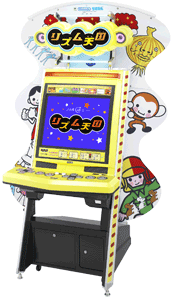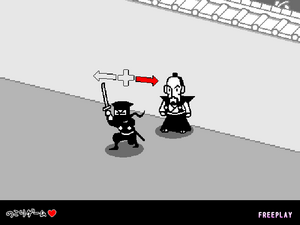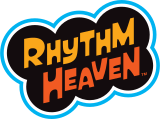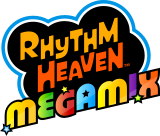
|
Rhythm Tengoku/Arcade: Difference between revisions
mNo edit summary |
No edit summary |
||
| Line 14: | Line 14: | ||
==Gameplay== | ==Gameplay== | ||
[[File:Kyotai.gif|thumb|left]] | [[File:Kyotai.gif|thumb|left]] | ||
Players start the game with two hearts. Each heart is lost when starting a [[Rhythm Game]]. Getting a [[Superb]] or [[Perfect]] gives an extra heart, as well as close the game for the rest of the Stage. If the player runs out of hearts, they will need to spend a credit to continue | Upon the machine first booting up, the title screen is displayed. When left alone, the game loops between the title screen, a demo of a [[Rhythm Game]] (each cycle alternating between each 1P and 2P game sequentially), followed by the {{Nihongo|High Score Ranking|ハイスコア ランキング|Hai Sukoa Rankingu}} screen, and then either the opening scene (in which [[Samurai Drummer]] welcomes the player to the game, which was also present when waiting on the title screen in the [[Rhythm Tengoku/GBA version]]), [[Neko Machine]] (which automatically starts playing its demo, but can also be interacted with for a limited time) or [[Kokuhaku Machine]] (which can also be interacted with for a limited time). When advancing from the title screen, the player is given the choice between the 1 Player mode or the 2 Player mode. After this, they choose which Stage to play, with all Stages being available to play. | ||
If the player enters the game's Service Mode, they can change several settings, including the number of hearts they start off with, how many coins need to be inserted for a credit (Freeplay is also available) and if the [[Remix]] is open from the start or not. The following information follows the default settings of two hearts, 1 coin per credit and closed [[Remix]]. | |||
Players start the game with two {{Rest Games|のこりゲーム|Nokori Gēmu}}, represented by hearts. Each heart is lost when starting a [[Rhythm Game]]. Getting a [[Superb]] or [[Perfect]] gives an extra heart, as well as close the game for the rest of the Stage, while getting an [[OK]] will mark the game as cleared, but the player can play it again to try getting a better [[Rank]]. If the player runs out of hearts, they will need to spend a credit to continue, otherwise the game is lost and goes back to the title screen. The player needs to clear all five games in the Stage with at least an [[OK]] to move on to the [[Remix]]. | |||
After the final game is cleared, the player is treated to a "Congratulations!" screen, featuring some [[Space Rabbits]], the [[Bon Dance Musume]] and [[Samurai Drummer]]. This happens even if the player got a [[Try Again]] and has no more extra lives, in which case [[Samurai Drummer]] thanks them for playing anyway<ref>"最後、『やりなおし』だったけど、ステージをやりとげました!ありがとう!!" (In the end, you got "Try Again", but you finished the stage! Thank you!!) ~ [[Samurai Drummer]], ''[[Rhythm Tengoku (Arcade)]]''</ref>. If the player got a high enough flow score at the end, they are prompted to enter their score, first by selecting their gender and then inputting their name. If the player tries to proceed through this screen without inputting a name, the game assigns one at random. In 2 Player mode, a compatibility test is also performed. | |||
Finally is a "The End" screen featuring the [[Girl]] and some [[Monkey]]s, with the player's flow displayed in the corner. The [[Girl]] asks the player to challenge the next stage<ref>"次のステージに 挑戦してね♪" (Challenge the next stage♪) ~ [[Girl]], ''[[Rhythm Tengoku (Arcade)]]''</ref>, or otherwise congratulates them and asks to come play again<ref>"おつかれさま☆ また、あそびにきてね♪" (Good work☆ Please, come and visit us again♪) ~ [[Girl]], ''[[Rhythm Tengoku (Arcade)]]''</ref>. If the player lost all their hearts and chose not to continue, the game goes to the "The End" screen with the [[Girl]] wishing the player luck next time<ref>"次はがんばってね♪" (Good luck next time♪) ~ [[Girl]], ''[[Rhythm Tengoku (Arcade)]]''</ref>. The game then goes back to the title screen. | |||
==Rhythm Games== | ==Rhythm Games== | ||
All of the [[Rhythm_Tengoku#List of Rhythm Games|Rhythm Games]] from ''[[Rhythm Tengoku]]'' are available in the {{Nihongo|1 Player|1人で遊ぶ|1-Ri de Asobu}} mode. The arcade version has an Extra stage as well. A selection of games are also present in the [[Two-Player Menu|2 Player]] mode. | All of the [[Rhythm_Tengoku#List of Rhythm Games|Rhythm Games]] from ''[[Rhythm Tengoku]]'' are available in the {{Nihongo|1 Player|1人で遊ぶ|1-Ri de Asobu}} mode. The arcade version has an Extra stage as well. A selection of games are also present in the {{Nihongo|[[Two-Player Menu|2 Player]]|2人で遊ぶ|2-Ri de Asobu}} mode. | ||
===1 Player=== | ===1 Player=== | ||
{{Quote|1人で遊ぶ<br>ひとリで遊ぶモードだよ"<br>"1 Player<br>It's a mode for one player}} | {{Quote|1人で遊ぶ<br>ひとリで遊ぶモードだよ"<br>"1 Player<br>It's a mode for one player}} | ||
| Line 24: | Line 32: | ||
|titleEN=STAGE 1 | |titleEN=STAGE 1 | ||
|explainEN=Welcome to Rhythm Tengoku♪<br>First, let's use this stage<br>to get used to the game!}} | |explainEN=Welcome to Rhythm Tengoku♪<br>First, let's use this stage<br>to get used to the game!}} | ||
<gallery position=center spacing=small> | <gallery position="center" spacing="small"> | ||
Prologue Arcade Karateka.png|[[Karate Man Returns!|Karateka]] | Prologue Arcade Karateka.png|[[Karate Man Returns!|Karateka]] | ||
Prologue Arcade Rhythm Tweezers 2.png|[[Rhythm Tweezers 2|Rhythm Datsumo]] | Prologue Arcade Rhythm Tweezers 2.png|[[Rhythm Tweezers 2|Rhythm Datsumo]] | ||
| Line 42: | Line 50: | ||
Prologue Arcade Rat Race.png|[[Rat Race|Kossori Rat]] | Prologue Arcade Rat Race.png|[[Rat Race|Kossori Rat]] | ||
Prologue Arcade Sick Beats.png|[[Sick Beats|Baikin Hakase]] | Prologue Arcade Sick Beats.png|[[Sick Beats|Baikin Hakase]] | ||
Prologue Arcade | Prologue Arcade The☆Bon Odori.png|[[The☆Bon Odori]] | ||
Prologue Arcade Remix 2.png|[[Remix 2 (GBA)|Remix 2]] | Prologue Arcade Remix 2.png|[[Remix 2 (GBA)|Remix 2]] | ||
</gallery> | </gallery> | ||
| Line 164: | Line 172: | ||
Prologue Arcade Rat Race.png|[[Kossori Rat 2P]] | Prologue Arcade Rat Race.png|[[Kossori Rat 2P]] | ||
Prologue Arcade Bunny Hop.png|[[Usagi Tobi 2P]] | Prologue Arcade Bunny Hop.png|[[Usagi Tobi 2P]] | ||
Prologue Arcade | Prologue Arcade The☆Bon Odori.png|[[The☆Bon Odori 2P]] | ||
</gallery> | </gallery> | ||
{{StageExplainArcade | {{StageExplainArcade | ||
| Line 219: | Line 227: | ||
</gallery> | </gallery> | ||
==Differences== | ==Differences== | ||
* | * The resolution is larger, and the graphics are manually upscaled to appear smoother. Most non-gameplay graphics are higher quality as well. | ||
*The games [[Spaceball|Air Batter]], [[Iai Giri]], [[Sick Beats|Baikin Hakase]], [[Bunny Hop|Usagi Tobi]], [[Night Walk]] and [[Polyrhythm]] now have {{Nihongo|Asobi Kata|あそびかた|How to Play}} demonstrations to make up for the lack of a [[Practice]]. [[Bouncy Road|Hopping Road]] also has one in addition to its [[Practice]]. All 2P games aside from the ones in Extra have these demonstrations as well, without a [[Practice]]. As these are merely animations, and not gameplay, minor differences from the games themselves can be found. | |||
*The games [[Spaceball|Air Batter]], [[Iai Giri]], [[Sick Beats|Baikin Hakase]], [[Bunny Hop|Usagi Tobi]], [[Night Walk]] and [[Polyrhythm]] now have {{Nihongo|Asobi Kata|あそびかた|How to Play}} | |||
*The player doesn't receive a [[Try Again]] for getting a question wrong in the [[Practice]] of [[Quiz Show]], the game simply moves on to the next question instead. Failing on the 5th question also gives a [[Just OK]]. Due to [[Perfect]] being a normal [[Rank]], getting a [[Superb]] is impossible. | *The player doesn't receive a [[Try Again]] for getting a question wrong in the [[Practice]] of [[Quiz Show]], the game simply moves on to the next question instead. Failing on the 5th question also gives a [[Just OK]]. Due to [[Perfect]] being a normal [[Rank]], getting a [[Superb]] is impossible. | ||
[[File:Screenshot Arcade Ninja.png|thumb]] | [[File:Screenshot Arcade Ninja.png|thumb]] | ||
*If the player has played perfectly for the first half of a [[Rhythm Game]], the "Go for a [[Perfect]]!" notice will appear on the bottom of the screen. Obtaining it is little different from a [[Superb]], however. | |||
*[[Ninja Bodyguard|Ninja]] and [[Ninja no Shison]] use the {{Nihongo|Left}} and {{Nihongo|Right}} buttons, instead of ✚ and Ⓐ. The arrows above the player are changed accordingly. | *[[Ninja Bodyguard|Ninja]] and [[Ninja no Shison]] use the {{Nihongo|Left}} and {{Nihongo|Right}} buttons, instead of ✚ and Ⓐ. The arrows above the player are changed accordingly. | ||
* | *[[Rhythm-kan Check]], [[Rhythm Shiryo Shitsu]], [[Studio]], [[Café]], [[Rhythm Toys|Toys]], [[Endless Games|Games]], [[Drum Lesson]], [[Staff]], and [[Live]] are all absent from this version. Most of the music unique to them has been repurposed for new features in this version. | ||
*The | **[[Neko Machine]] and [[Kokuhaku Machine]] can be seen in the attract mode instead, where they can be interacted with for a limited time. | ||
* | **The [[Drum Girls]] make a cameo on the Player Mode menu. | ||
**A majority of these still exist in the game and can be accessed through [[Sequence Test]], including the [[Rhythm Tengoku|GBA version]]s of the Title screen, Menu and Game Select. | |||
==Gallery== | ==Gallery== | ||
<gallery> | <gallery> | ||
Congratulations screen arcade.png|This screen is seen when the players completes a Stage. | |||
Highscore gender arcade.png|If the player has a high enough flow at the end of the Stage, they register it into the High Score Ranking. First by selecting their gender... | |||
Congarts! (Enter your Name).png|Then by entering their name. | |||
End screen arcade.png|Regardless of whether or not the player gets a high score, they will always see this screen, with the [[Girl]] telling them to try the next stage. | |||
start.jpg| After completeing a 2 player stage. | |||
Screenshot 12.jpg|During the 2 player compatibility check. | |||
Screenshot 12.1.jpg|2 player high score screen. | |||
</gallery> | </gallery> | ||
==Official Websites== | ==Official Websites== | ||
| Line 250: | Line 255: | ||
==Trivia== | ==Trivia== | ||
*This is one of the very few games developed by Nintendo ''and'' SEGA. | *This is one of the very few games developed by Nintendo ''and'' SEGA. | ||
*This was playable in Hyper Japan 2016 in London. | *This game was playable in Hyper Japan 2016 in London. | ||
* This is the first game in the series to have a Two Player mode. | * This is the first game in the series to have a Two Player mode. | ||
**Although, the first multiplayer game in the main series would be ''[[Rhythm Heaven Fever]]''. | **Although, the first multiplayer game in the main series would be ''[[Rhythm Heaven Fever]]''. | ||
Revision as of 00:01, 21 July 2023
JP Room
| CERO: |
Rhythm Tengoku
Rhythm Heaven
Rhythm Tengoku (リズム天国?, Rhythm Tengoku) is an arcade port of Rhythm Tengoku for the Game Boy Advance. It was developed by Nintendo and published by SEGA. It was released on September 20, 2007 in Japan.
Gameplay
Upon the machine first booting up, the title screen is displayed. When left alone, the game loops between the title screen, a demo of a Rhythm Game (each cycle alternating between each 1P and 2P game sequentially), followed by the High Score Ranking (ハイスコア ランキング?, Hai Sukoa Rankingu) screen, and then either the opening scene (in which Samurai Drummer welcomes the player to the game, which was also present when waiting on the title screen in the Rhythm Tengoku/GBA version), Neko Machine (which automatically starts playing its demo, but can also be interacted with for a limited time) or Kokuhaku Machine (which can also be interacted with for a limited time). When advancing from the title screen, the player is given the choice between the 1 Player mode or the 2 Player mode. After this, they choose which Stage to play, with all Stages being available to play.
If the player enters the game's Service Mode, they can change several settings, including the number of hearts they start off with, how many coins need to be inserted for a credit (Freeplay is also available) and if the Remix is open from the start or not. The following information follows the default settings of two hearts, 1 coin per credit and closed Remix.
Players start the game with two Template:Rest Games, represented by hearts. Each heart is lost when starting a Rhythm Game. Getting a Superb or Perfect gives an extra heart, as well as close the game for the rest of the Stage, while getting an OK will mark the game as cleared, but the player can play it again to try getting a better Rank. If the player runs out of hearts, they will need to spend a credit to continue, otherwise the game is lost and goes back to the title screen. The player needs to clear all five games in the Stage with at least an OK to move on to the Remix.
After the final game is cleared, the player is treated to a "Congratulations!" screen, featuring some Space Rabbits, the Bon Dance Musume and Samurai Drummer. This happens even if the player got a Try Again and has no more extra lives, in which case Samurai Drummer thanks them for playing anyway[1]. If the player got a high enough flow score at the end, they are prompted to enter their score, first by selecting their gender and then inputting their name. If the player tries to proceed through this screen without inputting a name, the game assigns one at random. In 2 Player mode, a compatibility test is also performed.
Finally is a "The End" screen featuring the Girl and some Monkeys, with the player's flow displayed in the corner. The Girl asks the player to challenge the next stage[2], or otherwise congratulates them and asks to come play again[3]. If the player lost all their hearts and chose not to continue, the game goes to the "The End" screen with the Girl wishing the player luck next time[4]. The game then goes back to the title screen.
Rhythm Games
All of the Rhythm Games from Rhythm Tengoku are available in the 1 Player (1人で遊ぶ?, 1-Ri de Asobu) mode. The arcade version has an Extra stage as well. A selection of games are also present in the 2 Player (2人で遊ぶ?, 2-Ri de Asobu) mode.
1 Player
|
1人で遊ぶ |
|
|
|---|
- Prologue Arcade Karateka.png
|
|
|---|
|
|
|---|
|
|
|---|
|
|
|---|
When scrolling past STAGE 5, the player receives a notice.
|
|
|---|
|
|
|---|
|
|
|---|
- Prologue Arcade Karateka.png
|
|
|---|
|
|
|---|
- Prologue Arcade Karateka Extra.png
2 Player
|
2人で遊ぶ |
|
|
|---|
- Prologue Arcade Karateka.png
|
|
|---|
|
|
|---|
|
|
|---|
- Prologue Arcade Karateka.png
|
|
|---|
When scrolling past STAGE 5, the players receives a notice.
|
|
|---|
|
|
|---|
- Prologue Arcade Karateka Extra.png
Differences
- The resolution is larger, and the graphics are manually upscaled to appear smoother. Most non-gameplay graphics are higher quality as well.
- The games Air Batter, Iai Giri, Baikin Hakase, Usagi Tobi, Night Walk and Polyrhythm now have Asobi Kata (あそびかた?, How to Play) demonstrations to make up for the lack of a Practice. Hopping Road also has one in addition to its Practice. All 2P games aside from the ones in Extra have these demonstrations as well, without a Practice. As these are merely animations, and not gameplay, minor differences from the games themselves can be found.
- The player doesn't receive a Try Again for getting a question wrong in the Practice of Quiz Show, the game simply moves on to the next question instead. Failing on the 5th question also gives a Just OK. Due to Perfect being a normal Rank, getting a Superb is impossible.
- If the player has played perfectly for the first half of a Rhythm Game, the "Go for a Perfect!" notice will appear on the bottom of the screen. Obtaining it is little different from a Superb, however.
- Ninja and Ninja no Shison use the Left and Right buttons, instead of ✚ and Ⓐ. The arrows above the player are changed accordingly.
- Rhythm-kan Check, Rhythm Shiryo Shitsu, Studio, Café, Toys, Games, Drum Lesson, Staff, and Live are all absent from this version. Most of the music unique to them has been repurposed for new features in this version.
- Neko Machine and Kokuhaku Machine can be seen in the attract mode instead, where they can be interacted with for a limited time.
- The Drum Girls make a cameo on the Player Mode menu.
- A majority of these still exist in the game and can be accessed through Sequence Test, including the GBA versions of the Title screen, Menu and Game Select.
Gallery
Regardless of whether or not the player gets a high score, they will always see this screen, with the Girl telling them to try the next stage.
Official Websites
- リズム天国 公式ウェブサイト (Rhythm Tengoku Official Website) [Archive]
Logo
- LogoRhythmTengoku.svg
Trivia
- This is one of the very few games developed by Nintendo and SEGA.
- This game was playable in Hyper Japan 2016 in London.
- This is the first game in the series to have a Two Player mode.
- Although, the first multiplayer game in the main series would be Rhythm Heaven Fever.
Unused
- Main article: Rhythm Tengoku/Unused
In Other Languages
| Language | Name | Meaning |
|---|---|---|
| リズム天国 | Rhythm Heaven | |
| Rhythm Tengoku[5] | ||
| Rhythm Tengoku[6] | ||
| Rhythm Tengoku[7] | ||
| Rhythm Tengoku[8] | ||
| Rhythm Tengoku[9] | ||
| Rhythm Tengoku[10] | ||
| Rhythm Tengoku[11] | ||
| Rhythm Tengoku[12] |
References
- ↑ "最後、『やりなおし』だったけど、ステージをやりとげました!ありがとう!!" (In the end, you got "Try Again", but you finished the stage! Thank you!!) ~ Samurai Drummer, Rhythm Tengoku (Arcade)
- ↑ "次のステージに 挑戦してね♪" (Challenge the next stage♪) ~ Girl, Rhythm Tengoku (Arcade)
- ↑ "おつかれさま☆ また、あそびにきてね♪" (Good work☆ Please, come and visit us again♪) ~ Girl, Rhythm Tengoku (Arcade)
- ↑ "次はがんばってね♪" (Good luck next time♪) ~ Girl, Rhythm Tengoku (Arcade)
- ↑ Iwata Asks - Rhythm Heaven - Page 2
- ↑ Iwata Asks | 2. Rhythm Tengoku: The Arcade Game | Iwata Asks: Rhythm Paradise | Nintendo
- ↑ Iwata demande | 2. Rhythm Tengoku : le jeu d’arcade | Iwata demande : Rhythm Paradise | Nintendo
- ↑ Iwata pregunta | 2. Rhythm Tengoku: la recreativa | Iwata pregunta: Rhythm Paradise | Nintendo
- ↑ Iwata fragt | 2. Rhythm Tengoku: Das Arcade-Spiel | Iwata fragt: Rhythm Paradise | Nintendo
- ↑ Iwata Chiede | 2. Rhythm Tengoku: la versione arcade | Iwata Chiede: Rhythm Paradise | Nintendo
- ↑ Iwata vraagt | 2. Rhythm Tengoku: het arcadespel | Iwata vraagt: Rhythm Paradise | Nintendo
- ↑ Iwata Pergunta | 2. Rhythm Tengoku: o jogo arcade | Iwata Pergunta Rhythm Paradise | Nintendo
| ExpandRhythm Tengoku (GBA/Arcade) |
|---|
| ExpandRhythm Heaven Series |
|---|



































































